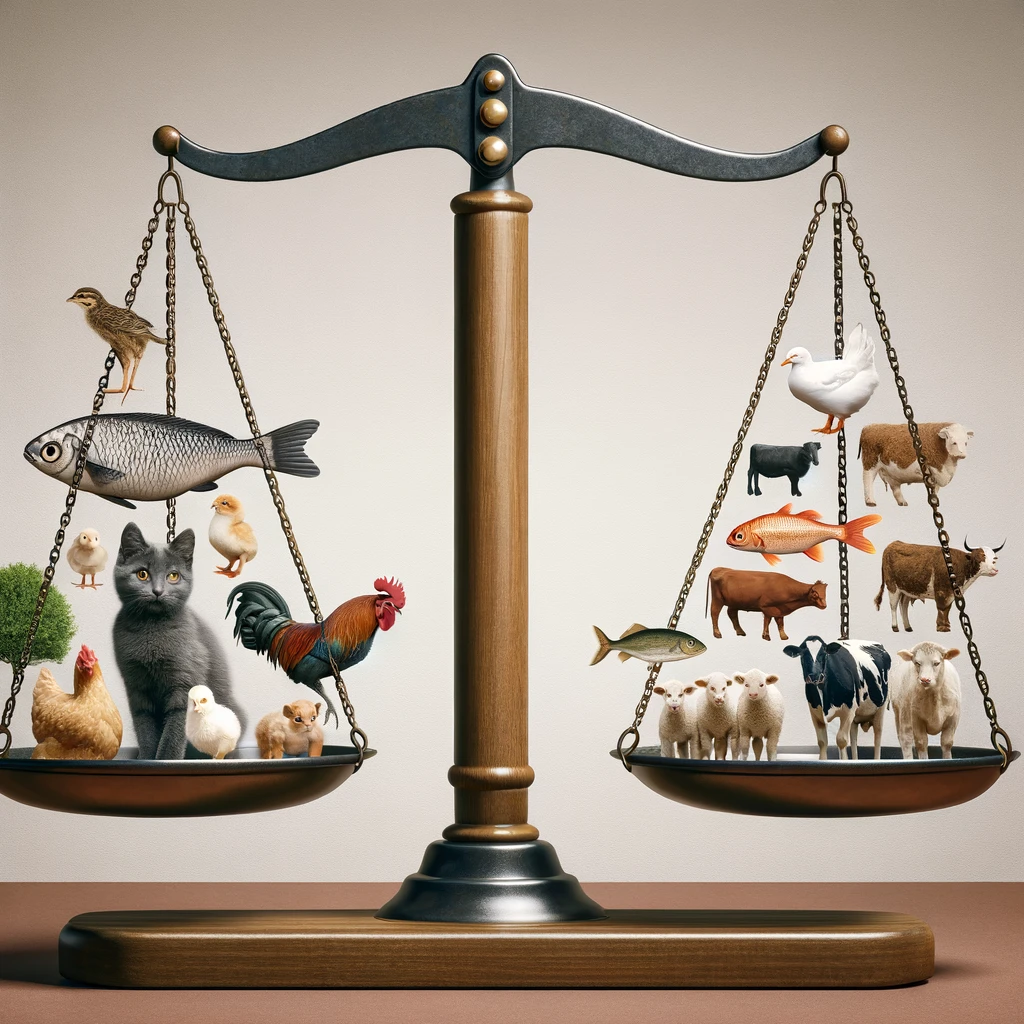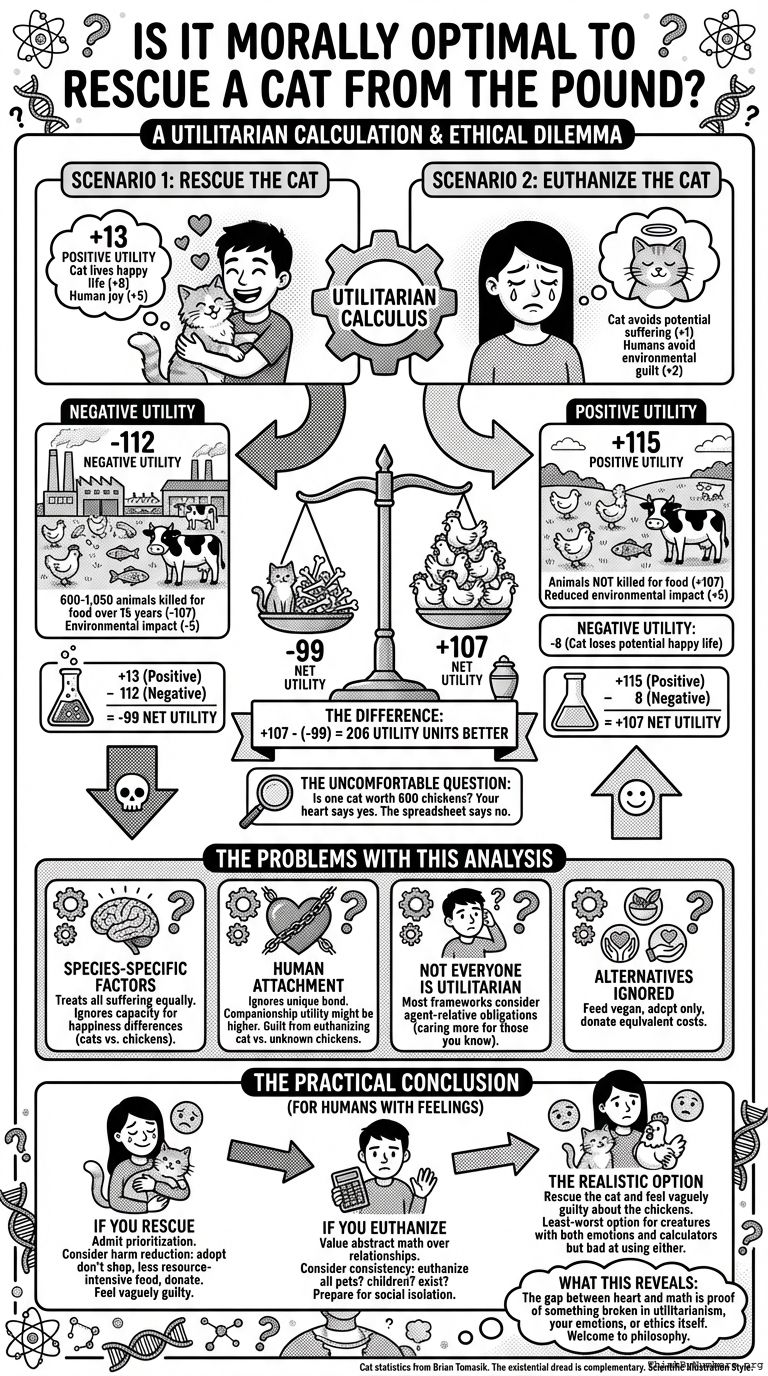From a strict utilitarian perspective, rescuing a cat from the pound creates net negative utility of -99. Euthanizing the cat creates net positive utility of +107.
This means killing the cat is 206 utility units better than saving it.
The math is third grade arithmetic. You have third grade arithmetic. The fact that this conclusion seems wrong tells you something about either utilitarianism or your emotions, but philosophers disagree on which.
The Calculation
Utility scale:
- Positive (pleasure): 0 to +10
- Negative (pain): 0 to -10
Scenario 1: Rescue the Cat
Positive utility:
- Cat lives longer, potentially happy life: +8
- Human companionship and joy: +5
- Total positive: +13
Negative utility:
- Other animals killed for cat food over 15 years:
- 450-750 chickens
- 150-300 fish
- Parts of cattle/pigs
- Total suffering: -107
- Environmental impact (resources, waste): -5
- Total negative: -112
Net utility: +13 - 112 = -99
Scenario 2: Euthanize the Cat
Positive utility:
- Cat avoids potential suffering in pound: +1
- Humans avoid environmental guilt: +2
- Animals not killed for cat food: +107
- Reduced environmental impact: +5
- Total positive: +115
Negative utility:
- Cat loses potential happy life: -8
Net utility: +115 - 8 = +107
The Difference
+107 - (-99) = 206 utility units
Euthanizing the cat produces 206 more utility units than rescuing it.
What This Actually Means
For the cat: You saved one life. The cat is happy (probably). You are happy (probably). This seems good.
For other animals: You killed approximately 600-1,050 chickens and fish to feed that one cat over its 15-year lifespan.
The exchange rate:
- You saved: 1 cat
- You killed: 600-1,050 other animals
- Net animal welfare: Very bad
- Your feelings: Very good
- The math: Does not care about your feelings
The uncomfortable question: Is one cat worth 600 chickens?
Your heart says yes. The spreadsheet says no. This is why most people aren't utilitarians - utilitarianism makes you do math when you'd rather just pet the cat.
The Problems with This Analysis
1. It ignores species-specific factors
- Cats might have higher capacity for happiness than chickens
- Or lower capacity
- We don't know
- The analysis treats all suffering equally
2. It ignores your attachment
- Humans bond with individual animals
- Utility from companionship might be higher than +5
- Guilt from euthanizing your cat might outweigh guilt from killing 600 chickens you never see
3. It assumes you're utilitarian
- Most people aren't
- Most ethical frameworks include agent-relative reasons to care more about beings you have relationships with
- "But what about the chickens?" is correct but unpopular at parties
4. It ignores alternatives
- Feed the cat vegan cat food (controversial, potentially harmful to cat)
- Adopt a cat that would die anyway but don't create demand for breeding more cats
- Donate money equivalent to cat costs to prevent more animal suffering elsewhere
- Don't own pets
The Utilitarian Conclusion (That Nobody Wants to Hear)
If you're a strict utilitarian who:
- Weighs all animal suffering equally (1 cat = 600 chickens)
- Counts only quantified utility (feelings don't matter, only numbers)
- Ignores special obligations to relationships (your cat is no more important than a random chicken in Iowa)
- Follows the math wherever it leads (even when it leads to killing your cat)
Then you should euthanize the cat.
This is one reason most people aren't strict utilitarians. The other reasons include:
- Utilitarianism tells you to donate all your money
- Utilitarianism says watching Netflix is morally equivalent to murder (opportunity cost)
- Utilitarianism requires you to calculate everything
- Calculating is exhausting
- Also you'd have to kill your cat
The Practical Conclusion (For Humans With Feelings)
If you rescue the cat:
- Be honest that you're prioritizing one animal you know over 600 animals you don't
- Admit this is not optimal from an impartial cosmic perspective
- Consider harm reduction:
- Adopt don't shop (don't create demand for new cats)
- Feed less resource-intensive food (beef cat food > fish cat food)
- Donate to animal welfare organizations (offset your moral deficit)
- Feel guilty at parties (the utilitarian way)
If you euthanize the cat:
- Be honest that you're valuing abstract math over concrete relationships
- Consider whether strict utilitarianism applied consistently is livable:
- Should you euthanize all pets?
- Should you have children? (They consume resources)
- Should you exist? (You also consume resources)
- Realize you've solved ethics by killing a cat, which is a weird flex
- Prepare to have no friends
The realistic option: Most people will rescue the cat and feel vaguely guilty about the chickens. This is probably the least-worst option for creatures who have both emotions AND calculators but aren't very good at using either.
What this reveals: The math says euthanize. Your heart says rescue. The gap between them is either:
- Proof that utilitarianism is wrong (most people)
- Proof that your emotions are wrong (utilitarians)
- Proof that ethics is impossible (philosophers)
- Proof that you should just get a fish tank (fish don't require killing 600 other animals) (wait yes they do) (there is no ethical consumption under late capitalism) (help)
This is what makes ethics simultaneously interesting and terrible. You can do the math perfectly and still arrive at "kill your cat," which suggests either:
- The math is missing something important
- Morality isn't math
- Your cat is doomed
Welcome to philosophy. The cat statistics are from Brian Tomasik. The existential dread is complementary.



Comments